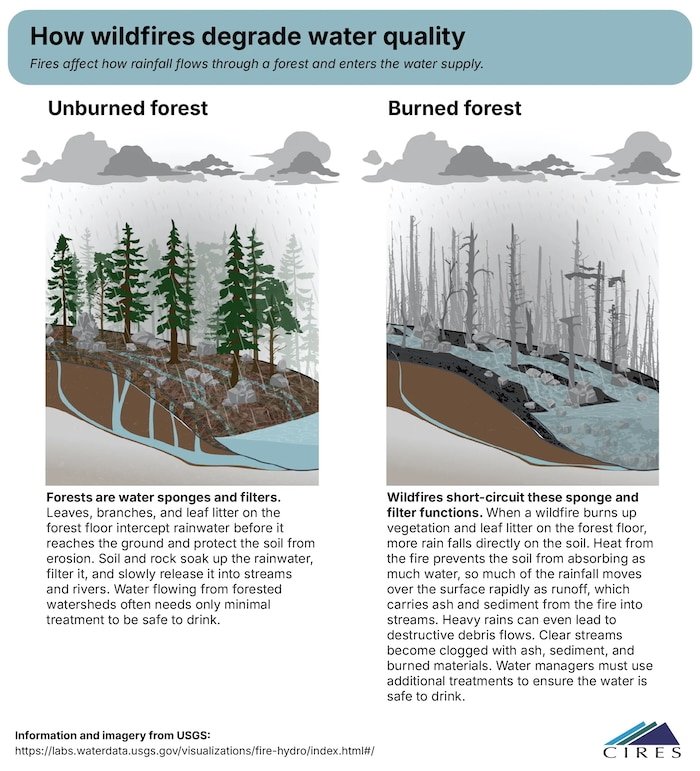It’s no secret that smoke and other contaminants from wildfires can pollute the air, soil and water during and after a blaze burns out. But now, scientists are warning that wildfire pollutants can continue to contaminate local waterways for up to eight years after a wildfire event.
In a new study, led by scientists at University of Colorado at Boulder’s Cooperative Institute for Research in Environmental Sciences (CIRES), experts analyzed 100,000 water samples from 538 watersheds around the western U.S., combining both observations on watersheds in burned areas from 1984 through 2021 and unburned watersheds.
“We were attempting to look at notable trends in post-wildfire water quality across the entire U.S. West, to help inform water management strategies in preparing for wildfire effects,” Carli Brucker, lead author of the study, said in a statement.
New research, led by CIRES, @wwanews.bsky.social, and @colorado.edu, featured in Grist!
— CIRES (@cires.colorado.edu) June 27, 2025 at 1:42 PM
The analysis revealed that nitrogen and sediment had highly elevated levels for up to eight years after a fire, and organic carbon and phosphorous levels increased for one to five years after a fire. The team published their findings in the journal Communications Earth & Environment.
“It can take two years, up to eight years, for the effect to be fully felt,” explained Ben Livneh, co-author of the study, CIRES fellow and Western Water Assessment director. “Sometimes it can be a delayed effect, meaning, it’s not all happening right away, or sometimes you need a big enough storm that will mobilize enough of the leftover contaminants.”
Carbon, nitrogen and phosphorus levels could reach three to 103 times the levels found in watersheds before a fire, the authors reported, and sediment levels after a fire could be 19 to 286 times higher compared to pre-fire watersheds.
The impact of a fire on a watershed depended on specific site conditions. Fires upstream may not leave as elevated contamination levels as a fire close to a river, for instance. Local plant life, soil variations and weather in an area could all influence how a wildfire impacted water quality. As CITES reported, these variations make it more challenging to create adaptation plans.
“There’s a huge amount of variability in sedimentation rates,” Brucker said. “Some streams are completely clear of sediment after wildfires, and some have 2000 times the amount of sediment.”
Despite the variations, the study does provide evidence that wildfires can harm water quality years after a single fire event, and the data can help local water management teams and policymakers to better mitigate these effects for future wildfires.
Previous research found that fire suppressants, specifically those used in the U.S., can further contribute to toxic metal pollution in the environment.
As the World Resources Institute reported, climate change is increasing wildfire risks, making these disasters more likely, more intense and more frequent. With worsening wildfire threats, officials will need to continue to prepare to handle wildfires and the contamination they leave behind.
“In particular, water utilities may consider the longevity and magnitude of the post-fire responses identified in this study as possible benchmarks — preparing for 1-8 years of elevated constituent loads following a wildfire event, with the potential for dramatic increases in magnitude up to 300 times pre-fire levels,” the authors wrote in the study.
“Such planning efforts are expected to become increasingly important in the western United States in the coming decades, as wildfire hazards are projected to proliferate with water resources already stressed by increasing drought driven by climate change,” the researchers concluded.

The post Water Contaminant Levels Can Remain High for Eight Years After a Wildfire, Study Finds appeared first on EcoWatch.















